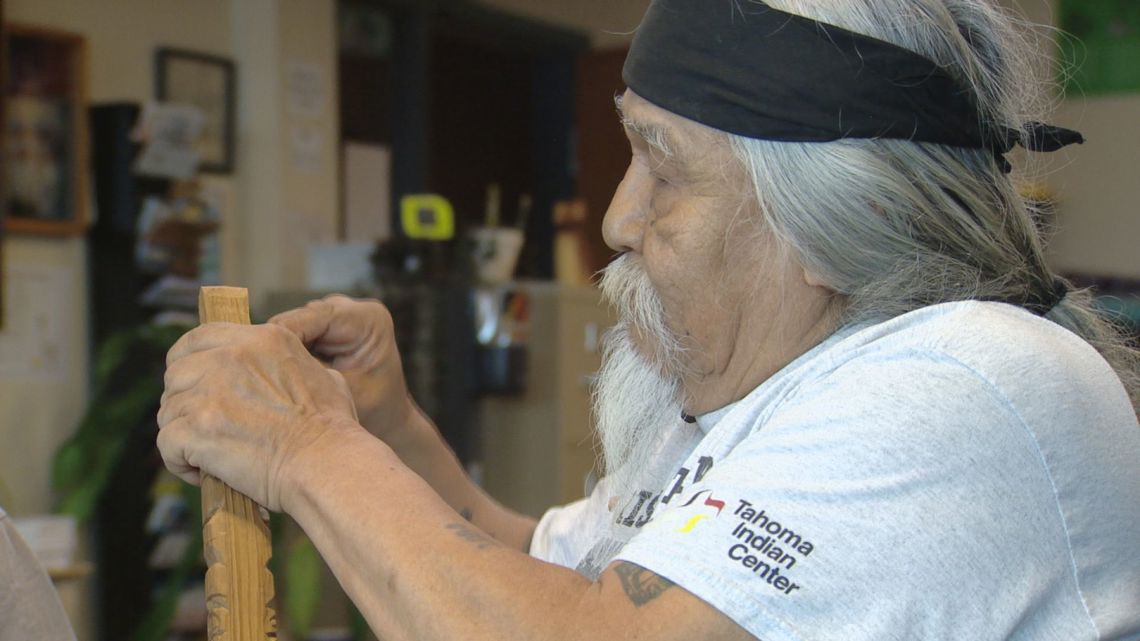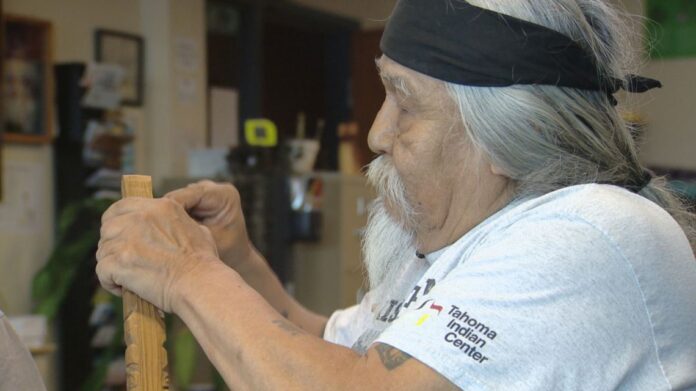
John T. Williams was a famous First Nations woodcarver living in Seattle. He was killed by a Seattle police officer.
SEATTLE — Tomorrow marks the 15th anniversary of the killing of First Nations Woodcarver John T. Williams at the hands of a Seattle Police officer.
The shooting ignited public outrage across the city.
Right now, at the intersection of Boren and Howell in downtown Seattle, three white deer stretch across the crosswalk. They’re Indigenous symbols of safe passage. They also mark the place where a Seattle police officer took the life of a man 15 years ago.
On August 30th, 2010, Officer Ian Birk fatally shot First Nations woodcarver John T Williams. Dashcam video from back then showed Williams on the ground, with Birk nearby shortly after the shooting.
John was carrying a piece of cedar and a small carving knife in his hand, a common tool of the trade. Officer Birk gave John four seconds to put the knife away. He waited four seconds before ending a life and shattering a family.
“Four point something seconds, to make a decision,” John’s brother Rick Williams said to reporters back in 2010. “What are you, God?”
Since his brother’s death, Rick Williams has carved every day.
“I enjoy it, I really enjoy it, like I said, I start feeling like my grandfather teaching what I know as a carver,” Williams said.
He can often be found teaching carving as a sacred Nuu-chah-nulth art form, as a way of expressing First Nations identity at the Tahoma Indian Center.
“It’s something I wanna teach to students here, it’s not about the money, it’s about heritage,” he added.
These days, Rick lives to carve. But there were days when Rick and his younger brother John carved to live.
“We were born into a famous carving family, to share our history. It’s in the history books that one of my great-grandfathers stood this close to the queen of England,” Williams said. “John was 12 when he first sold his carving to the Smithsonian, to the museum in England.”
All that stopped when John was given four seconds to drop his carving knife. The city of Seattle protested the shooting, demanding Birk be held responsible for John’s death.
In the aftermath, Rick said he felt there was too much focus on John’s struggles as an unhoused Indigenous man living with alcohol addiction.
“But you showed the last week of John’s life, that’s where your mentality is, and that’s exactly why you’re dismissed,” Williams said of the people who commented on John’s lifestyle. “They didn’t like him. I got tired of the way people put my brother down; they believed what the news said about John T’s last week of life.”
Seattle police officer Ian Birk resigned from the force, but never faced criminal charges. At the time, the police department released a photo of Williams’ knife open, against a ruler.
However, a federal investigation found that John’s carving knife was actually closed, and he never approached Officer Birk.
In 2012, the Seattle Police Department entered a federal consent decree, a court-ordered agreement with the Department of Justice, to reform the use of force, biased policing, and officer accountability.
“I think it’s actually getting worse, policing across the country,” Joseph Seia said.
Seia is one of the commissioners of the Seattle Community Policing Commission. The commission was formed shortly after the police department entered into a consent decree, as a part of a reform effort.
“Hearing about the way he was brutally murdered didn’t sit right with me, but I also understand it’s deep-seated, racial aggression that this country has against indigenous people, against Black people, and that continues to show up in ways we do policing,” Seia said.
However, Seia and the commission say it’s time to rely on local powers for change and to leave the federal consent decree behind.
A hearing to potentially drop the consent decree is scheduled for September 3rd.
“Change is going to enter at different levels, whether it’s at the federal level, local level, and I believe there is a strategy around having Seattle and the police commission, what it means to do change locally,” Seia added.
At the Seattle Center, under a totem pole’s shadow, Rick Williams adjusted to being close to John again.
“It’s been a couple of years since I sat here. Oh yeah, I’m home,” Williams said with a chuckle.
Rick installed the totem pole in 2012 as a tribute to his brother. He used a small carving knife to work on the pole, a feat many said he wouldn’t be able to accomplish.
“I usually look around to see if anyone is watching, and I go– give it a hug, ‘I’m still here bro,'” Williams said, hugging the totem pole.
He said while carving does remind him that his brother is gone, he finds the art healing.
“I hurt, I do miss my brother, and the world as I see it–I don’t want Native art to die in Seattle,” Williams said. “This is our heritage, this is our livelihood, this is the way we grew up. I spent 65 years of my life carving; I haven’t missed a day.”





